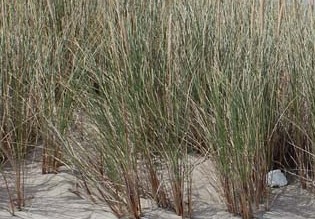
Introduced into the United States for dune stabilization, this coarse warm-season grass has become established throughout the Gulf and West Coast and in California it is considered a noxious weed. It is a member of the grass family, Poaceae, that also includes corn, rice, and bamboo. Its thick gray-green leaves are sharp, 1/8 to ¼ inch wide and up to five feet long, and have a waxy white cuticle and rolled edges so the leaves look cylindrical. When buried by sand the leaves elongate and adventitious roots form. Dense flower spikes up to twelve inches long appear green in spring and early summer and turn tan as they mature. European beach grass forms stiff compact colonies with thick, deep, scaly rhizomes that hold the soil in place. The rhizomes tolerate submersion in salt water and can spread the grass as they break off the mother plant, float elsewhere, and become established. The genus name, Ammophilia, comes from the Greek words ἄμμος (ámmos), meaning sand, and φίλος (philos), meaning friend, and refers to the favored habitat of the plant. The specific epithet, arenaria, comes from the Latin word arena, meaning sand and also refers to to the favored habitat of the plant.
Type: Warm-season grass

Bloom: Green spike up to twelve inches long appears in spring and early summer and turns tan with maturity.
Size: 2-3’ H
Light: Full sun
Soil: Sandy, well-drained
Hardiness: Zones 5-10
Care: Low maintenance
Pests and Diseases: None of significance
Propagation: Division in spring or fall; rarely produces seeds.
Companion Plants: Lathyrus japonicus ( sea pea, beach pea), Achillea millefolium (common yarrow), Rosa rugosa
Photo Credit: Wikipedia
